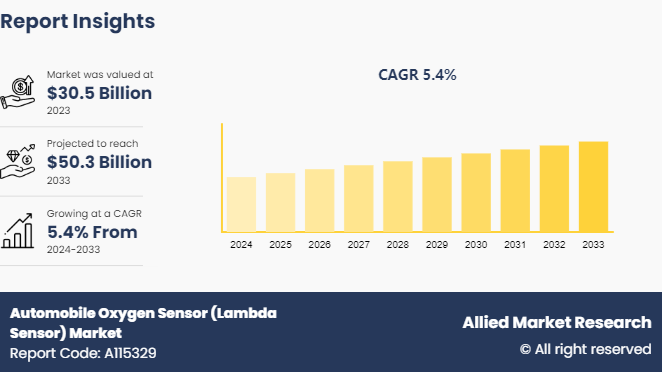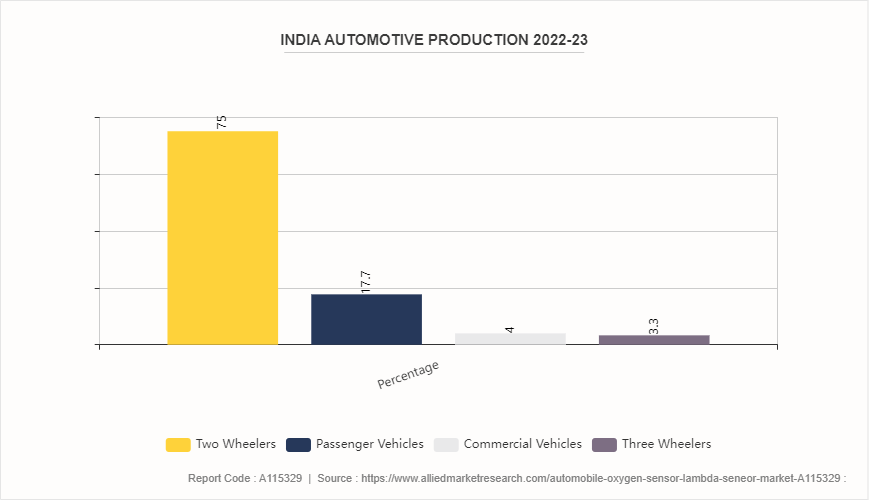Automobile Oxygen Sensor Market Research, 2033
The global automobile oxygen sensor (Lambda sensor) market was valued at $30.5 billion in 2023, and is projected to reach $50.3 billion by 2033, growing at a CAGR of 5.4% from 2024 to 2033.

Market Introduction and Definition
An automobile oxygen sensor market (lambda sensor) , also known as an O2 sensor, and automobile lambda sensor market is a crucial component in a vehicle's exhaust system. Its primary function is to measure the proportion of oxygen in the exhaust gases emitted by the engine. This measurement helps to determine how efficiently the engine is burning fuel and whether the air-fuel mixture is optimal for combustion.
The automobile oxygen sensor industry monitors the oxygen levels in the exhaust gases. It provides real-time data to the engine control unit (ECU) , which uses this information to adjust the air-fuel mixture for optimal combustion, enhancing fuel efficiency and reducing emissions.
Key Takeaways
The automobile lambda sensor market study covers 20 countries. The research includes a segment analysis of each country in terms of value for the projected period.
More than 1, 500 product literature, industry releases, annual reports, and other such documents of major automotive oxygen sensor industry participants along with authentic industry journals, trade associations' releases, and government websites have been reviewed for generating high-value industry insights.
The study integrated high-quality data, professional opinions and analysis, and critical independent perspectives. The research approach is intended to provide a balanced view of global markets and to assist stakeholders in making educated decisions in order to achieve their most ambitious growth objectives.
Recent Key Strategies and Developments
In February 2023, Fedrigoni S.P.A acquired a new R&D center in Grenoble, France to enhance its production innovation path and meet the growing consumer demand for innovative automotive films and wraps.
In April 2021, the Grafityp launched a new color wrapping that is chalk gray, which allows vehicle owners a sophisticated and contemporary option for vehicle customization. Chalk Grey is a versatile color choice that provides a modern aesthetic while maintaining a timeless appeal.
Key Market Dynamics
The increase in consumer preference toward vehicles with advanced features is a significant driver of the automobile oxygen sensor market size. Modern vehicles are equipped with sophisticated engine management systems that rely on accurate data from oxygen sensors to optimize air-fuel mixtures. This ensures better engine performance, fuel efficiency, and lower emissions, which are attractive features for consumers seeking advanced automotive technology. Furthermore, rise in vehicle production and advancements in sensor technology have driven the demand for the automobile oxygen sensor market growth.
However, high cost of advanced sensors has hampered the growth of the automobile oxygen sensor market size. Advanced sensors include sophisticated technologies such as wideband sensing capabilities, which provide more accurate and comprehensive data compared to traditional narrowband sensors. This technological complexity adds to the production costs. Moreover, durability and maintenance and economic uncertainties issue are major factors that hamper the growth of the automobile oxygen sensor market share. On the contrary, expansion of vehicles is a lucrative opportunity for the automobile oxygen sensor market trends. Rapid industrialization and urbanization in countries such as India, China, and Brazil are leading to increased vehicle production and sales. The growing automotive markets in these regions present significant opportunities for the oxygen sensor market, particularly as these countries adopt stricter emission norms.
Vehicle Safety and Security System Adoption of Global Automotive Oxygen Sensor Market
Modern vehicles feature integrated systems where safety, security, and emission control work in harmony. Advanced oxygen sensors are critical for maintaining optimal engine performance and reducing emissions, which in turn supports the reliable operation of safety and security systems. For example, features like adaptive cruise control and collision avoidance systems require precise engine management to function correctly. Regulations aimed at improving vehicle safety often coincide with stricter emission standards. To meet these comprehensive regulations, automotive manufacturers are increasingly adopting advanced oxygen sensors that help ensure engines operate efficiently, produce fewer emissions, and maintain the performance required for advanced safety and security systems.
Consumers today demand vehicles that offer not only safety and security but also efficiency and low environmental impact. Vehicles equipped with advanced safety systems are expected to be fuel-efficient and environmentally friendly, which necessitates the use of high-quality oxygen sensors to maintain these attributes.

Market Segmentation
The automotive oxygen sensor market is segmented into type, distribution channel, vehicle type, and region. On the basis of type, the market is divided into oxygen sensor, and dynamic sensor. As per distribution channel, the market is segregated into OEM, and Aftermarket. On the basis of vehicle type, the market is bifurcated into passenger cars, and commercial vehicles. Region wise, the market is analyzed across North America, Europe, Asia-Pacific, Latin America, and Middle East Africa.
Regional/Country Market Outlook
North America, particularly the U.S. and Canada, has some of the strictest emission regulations globally. Agencies such as the Environmental Protection Agency (EPA) and the California Air Resources Board (CARB) set rigorous standards that necessitate the use of advanced oxygen sensors to ensure vehicles comply with emission limits. These regulations drive the demand for high-quality, reliable oxygen sensors. North America is a hub for automotive innovation and technology. The region's focus on developing and adopting advanced automotive technologies, including sophisticated engine management systems, enhances the demand for advanced oxygen sensors. These sensors are critical for optimizing fuel efficiency and reducing emissions in modern vehicles.
North America has a substantial automotive industry with significant vehicle production and sales volumes. Major automotive manufacturers operate extensive production facilities in the region, creating a robust demand for automotive components, including oxygen sensors. The high turnover of vehicles, including both new sales and the replacement market, further boosts demand. North American consumers have a strong preference for vehicles that offer advanced features, including enhanced fuel efficiency and lower emissions. This consumer trend drives the adoption of vehicles equipped with advanced oxygen sensors, contributing to market growth.
In February 2023, Fedrigoni S.P.A acquired a new R&D center in Grenoble, France to enhance its production innovation path and meet the growing consumer demand for innovative automotive films and wraps.
In March 2021, Avery Dennison Corporation announced the launch of a new upgraded supreme wrapping film for vehicles with twelve new colors in its Rugged Range and Sleek Satin collections.
June 2021: Arlon Graphics announced that it has developed a new cast wrap film named premium color change for fleet and vehicle applications.
In August 2021, KPMF introduces a premium visualizer tool to aid wrap shops and installers worldwide in promoting KPMF products, allowing customers to select the ideal KPMF color for their vehicles. Developed in partnership with AAV, the visualizer meticulously recreates the entire KPMF range of wrap colors and finishes, offering features such as multiple vehicles, varied environments, and the flexibility to adjust the time of day. This tool, available at no cost, enhances the customer experience and facilitates informed decision-making when choosing KPMF wraps.
Competitive Landscape
The report analyzes the profiles of key players operating in the automotive oxygen sensor market such as BBT Automotive Components GmbH, BorgWarner Inc., Ceradex Corporation, Continental AG, Denso Corporation, Francisco Albero SAU., Fujikura Ltd, HELLA GmbH & Co. KGaA, NGK Spark Plug Co. Ltd, and Robert Bosch GmbH. These players have adopted various strategies to increase their market penetration and strengthen their position in the Automotive Oxygen Sensor market.
Industry Trends
In September 2021, Denso expanded its line of first-time fit oxygen sensors for every vehicle. The expansion means that DENSO is adding more sensor types and models to its lineup, covering a wider range of vehicle makes and models. This ensures that more vehicle owners and mechanics can find a compatible DENSO sensor for their specific needs.
In December 2023, NTK Vehicle Electronics' addition of 35 new wideband oxygen sensors to its product range represents a significant enhancement of its offerings in the automotive aftermarket. By adding 35 new wideband oxygen sensors, NTK is expanding its range to cover more vehicle makes and models. This ensures that a wider variety of customers can find the appropriate sensor for their specific vehicle, increasing the applicability and market reach of NTK's products.
In June 2023, HEXIS partnered with protect Monte Carlo, a renowned manufacturer of premium automotive paint protection films (PPF) . This partnership signifies a strategic collaboration between two industry leaders to offer enhanced solutions for vehicle protection and customization.
In March 2024, ORAFOL, a prominent manufacturer of self-adhesive special films for the graphic industry, unveiled a range of new products for full car wrapping and digital printing materials at the prestigious FESPA international trade exhibition. Visitors can experience live car wrapping demonstrations at ORAFOL's booth G60 in hall 5 throughout the event, showcasing the versatility and quality of their products. In Addition, expert consultation will be available for the application of multi-layer cast and digitally printable films, catering to various car wrapping and other application needs
Key Sources Referred
INTERNATIONAL ENERGY OUTLOOK
Environmental and Energy Study Institute (EESI)
U.S. Department of Energy
ITRI Ltd.
International Hydropower Association
International Energy Agency
World Economic Forum
European Association for Storage of Energy
Key Benefits for Stakeholders
This report provides a quantitative analysis of the automotive oxygen sensor market segments, current trends, estimations, and dynamics of the market analysis from 2024 to 2033 to identify the prevailing market opportunities.
Market research is offered along with information related to key drivers, restraints, and Automobile oxygen sensor market opportunity.
Porter's five forces analysis highlights the potency of buyers and suppliers to enable stakeholders to make profit-oriented business decisions and strengthen their supplier-buyer network.
In-depth analysis of the automotive oxygen sensor market segmentation assists to determine the prevailing automobile oxygen sensor market forecast.
Major countries in each region are mapped according to their revenue contribution to the global automotive oxygen sensor market statistics.
Market player positioning facilitates benchmarking and provides a clear understanding of the present position of the market players.
The report includes the analysis of the regional as well as global automotive oxygen sensor market trends, key players, market segments, application areas, and market growth strategies.
Automobile Oxygen Sensor (Lambda Sensor) Market Report Highlights
| Aspects | Details |
| Market Size By 2033 | USD 50.3 Billion |
| Growth Rate | CAGR of 5.4% |
| Forecast period | 2024 - 2033 |
| Report Pages | 488 |
| By Type |
|
| By Distribution Channel |
|
| By Vehicle Type |
|
| By Region |
|
| Key Market Players | BBT Automotive Components GmbH, Ceradex Corporation, DENSO CORPORATION, Francisco Albero SAU, BorgWarner Inc., NGK Spark Plug Co. Ltd, HELLA GmbH & Co. KGaA, Robert Bosch GmbH, Fujikura Ltd., Continental AG |
Upcoming trends in the global automobile oxygen sensor (Lambda Sensor) Market include the adoption of advanced sensor technologies for enhanced accuracy and durability, increasing use in electric and hybrid vehicles for better emissions control, and the integration of IoT for real-time monitoring and diagnostics.
The leading application of the automobile oxygen sensor (Lambda Sensor) Market is to monitor and optimize the air-fuel mixture in internal combustion engines, ensuring efficient fuel combustion and reducing emissions.
North America is the largest regional market for automobile oxygen sensor (Lambda Sensor)
$50.3 billion is the estimated industry size of automobile oxygen sensor (Lambda Sensor)
BBT Automotive Components GmbH, BorgWarner Inc., Ceradex Corporation, Continental AG, Denso Corporation, Francisco Albero SAU., Fujikura Ltd, HELLA GmbH & Co. KGaA, NGK Spark Plug Co. Ltd, and Robert Bosch GmbH are the top companies to hold the market share in Automobile Oxygen Sensor (Lambda Sensor)
Loading Table Of Content...



